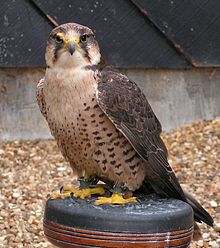Lanner falcon
| Lanner falcon | |
|---|---|

| |
| Adult Falco biarmicus feldeggi | |
| Scientific classification | |
| Kingdom: | |
| Phylum: | |
| Class: | |
| Order: | |
| Family: | |
| Genus: | |
| Subgenus: | |
| Species: | F. biarmicus
|
| Binomial name | |
| Falco biarmicus Temminck, 1825
| |
| Synonyms | |
|
Falco feldeggii Schlegel, 1843[notes 1] | |
The lanner falcon (Falco biarmicus)[notes 2] is a medium-sized bird of prey that breeds in Africa, southeast Europe and just into Asia. It is mainly resident, but some birds disperse more widely after the breeding season.
Description


It is a large falcon, at 43–50 cm (17–20 in) length with a wingspan of 95–105 cm (37–41 in). European lanner falcons (Falco biarmicus feldeggi, also called Feldegg's falcon) have slate grey or brown-grey upperparts; most African subspecies are a paler blue grey above. The breast is streaked in northern birds, resembling greyish saker falcons, but the lanner has a reddish back to the head. Sexes are similar, but the browner young birds resemble saker falcons even more. However, sakers have a lighter top of the head and less clear head-side patterns. The lanner's call is a harsh "wray-e".
Taxonomy and systematics
The lanner falcon is a bird of open country and savanna. It usually hunts by horizontal pursuit, rather than the peregrine falcon's stoop from a height, and takes mainly bird prey in flight. It lays three to four eggs on a cliff ledge nest, or occasionally in an old stick nest in a tree.
This is presumably the oldest living hierofalcon species. Support for this assumption comes mainly from biogeography agreeing better with the confusing pattern of DNA sequence data in this case than in others. Nonetheless, there is rampant hybridization (see also perilanner) and incomplete lineage sorting which confounds the data to a massive extent; molecular studies with small sample sizes can simply not be expected to yield reliable conclusions in the entire hierofalcon group. In any case, the radiation of the entire living diversity of hierofalcons seems to have taken place in the Eemian interglacial at the start of the Late Pleistocene, a mere 130,000–115,000 years ago; the lanner falcons would thus represent the lineage that became isolated in sub-Saharan Africa at some time during the Riss glaciation (200,000 to 130,000 years ago) already.[2][3][4][5]
They are bred in captivity for falconry; hybrids with the peregrine ("perilanners") are also often seen. Merret (1666) claimed that the "lanar" lived in Sherwood Forest and the Forest of Dean in England; such populations would seem to have derived from escaped hunting birds of the nobility.[6]
In the wild, lanner falcon numbers are somewhat declining in Europe, though the species remains relatively common in parts of Africa.
Jackdaw flocks are targets of coordinated hunting by pairs of lanner falcons, although larger flocks are more able to elude becoming prey.[7] In Africa and Israel, lanner falcons were observed as hunting bats.[8]
Gallery
-
Painting by John Gerrard Keulemans (1884)
-
Lanner falcon at Plettenberg Bay, South Africa
-
Adult Falco biarmicus biarmicus, Etosha National Park, Namibia.
-
A falconer's lanner in a dive. Note distinct head coloration.
-
Juvenile, probably F. b. feldeggi. Note blue facial skin and overall similarity to saker falcon.
-
A gyrfalcon's head showing the "twice-armed" falcon bill (number 2).
Notes
- ^ Possibly 1841 (Sharpe 1874, p. 389), or 1844 (Strickland 1855, p. 80).
- ^ Etymology: Falco, Latin for a falcon. biarmicus, Latin for "being twice armed", in reference to the additional sharp points behind the billtip. These are typical of falcons in general however, not just this species.
References
- ^ Template:IUCN
- ^ Helbig, A.J.; Seibold, I.; Bednarek, W.; Brüning, H.; Gaucher, P.; Ristow, D.; Scharlau, W.; Schmidl, D.; Wink, Michael (1994). Meyburg, B.-U.; Chancellor, R.D. (eds.). Phylogenetic relationships among falcon species (genus Falco) according to DNA sequence variation of the cytochrome b gene (PDF). Raptor conservation today. pp. 593–599.
- ^ Wink, Michael; Seibold, I.; Lotfikhah, F.; Bednarek, W. (1998). Chancellor, R.D.; Meyburg, B.-U.; Ferrero, J.J. (eds.). Molecular systematics of holarctic raptors (Order Falconiformes) (PDF). Adenex & WWGBP. pp. 29–48.
{{cite book}}:|work=ignored (help) - ^ Nittinger, F.; Haring, E.; Pinsker, W.; Wink, Michael; Gamauf, A. (2005). "Out of Africa? Phylogenetic relationships between Falco biarmicus and other hierofalcons (Aves Falconidae)" (PDF). Journal of Zoological Systematics and Evolutionary Research. 43 (4): 321–331. doi:10.1111/j.1439-0469.2005.00326.x.
- ^ Wink, Michael; Sauer-Gürth, Hedi; Ellis, David; Kenward, Robert (2004). Chancellor, R.D.; Meyburg, B.-U. (eds.). Phylogenetic relationships in the Hierofalco complex (Saker-, Gyr-, Lanner-, Laggar Falcon) (PDF). Berlin: WWGBP. pp. 499–504.
{{cite book}}:|work=ignored (help) - ^ Merret, Christopher (1666). Pinax rerum naturalium Britannicarum continens vegetabilia, animalia et fossilia, in hac insula reperta inchoatus (in Latin). London: Pulleyn and F. & T. Warren.
- ^ Leonardi, Giovanni (1999). "Cooperative Hunting of Jackdaws by the Lanner Falcon (Falco biarmicus)" (PDF). Journal of Raptor Research. 33 (2): 123–127.
- ^ Mikula, P.; Morelli, F.; Lučan, R. K.; Jones, D. N.; Tryjanowski, P. (2016). "Bats as prey of diurnal birds: a global perspective". Mammal Review. doi:10.1111/mam.12060.
- Sharpe, Richard Bowdler (1874). Catalogue of the birds in the British Museum. Vol. 1. London: British Museum (Natural History).
{{cite book}}: Invalid|ref=harv(help) - Strickland, Hugh Edwin (1855). Ornithological Synonyms. London: J. Van Voorst.
{{cite book}}: Invalid|ref=harv(help)
External links
- Lanner falcon species text in The Atlas of Southern African Birds.
- BirdLife species factsheet for Falco biarmicus
- "Falco biarmicus". Avibase.
- "Lanner falcon media". Internet Bird Collection.
- Lanner falcon photo gallery at VIREO (Drexel University)
- Interactive range map of Falco biarmicus at IUCN Red List maps
- Audio recordings of Lanner falcon on Xeno-canto.







